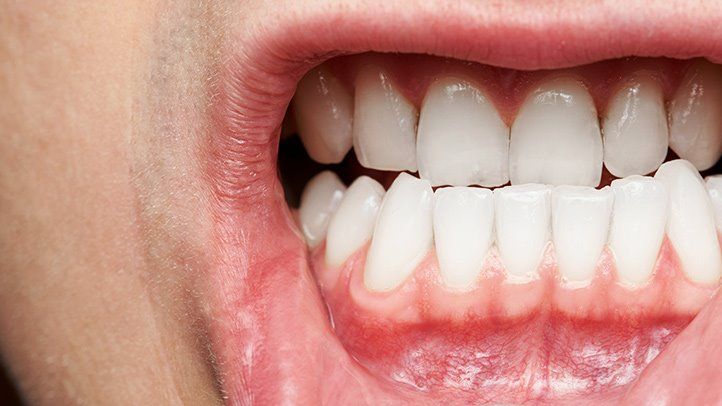What You Need to Know About Gum Disease

[ad_1]
More than 4 in 10 of U.S. adults age 30 and older have some form of periodontal disease, also known as gum disease, according to the National Institute of Dental and Craniofacial Research. Along with tooth decay, gum disease poses the biggest threat to dental health.
Types of Gum Disease and What They Look Like
Early-stage gum disease is known as gingivitis. Most commonly the result of poor oral health, gingivitis causes the gums to become red and swollen. Other signs are bad breath and bleeding gums when you brush your teeth or floss.
“There is a tight cuff around your gums,” says Vera W. L. Tang, doctor of dental surgery and clinical assistant professor of periodontology and implant dentistry at the NYU College of Dentistry in New York City. “When irritated, it becomes swollen and forms a gap between the tooth and gum. It can become enlarged, and it allows food and bacteria to get trapped and embedded around the tooth.”
“Preventing gingivitis comes down to oral hygiene and keeping your teeth clean,” says Dr. Tang. If it’s caught early on, gingivitis is usually treatable. Treatment typically involves a thorough professional cleaning, known as scaling. The condition usually clears up if you maintain good oral hygiene and get regular checkups, notes the Mayo Clinic.
If it’s not properly treated, gingivitis can progress to periodontitis, a serious condition that causes the gums to pull away from the tooth and form pockets. Bacteria can collect in these pockets, leading to infection and potential bone loss. Teeth can become loose and require extraction.
Certain factors, including smoking and diabetes, can increase the risk of gingivitis turning into periodontitis, Tang says. Having a family history of gum disease or early tooth loss can also play a role. If you have any of these risk factors, “you need to address periodontal disease proactively,” she says.
How to Prevent Serious Gum Disease
You want to catch gingivitis before it becomes periodontitis, says Angelo Mariotti, DDS, PhD, dean of the LSU Health New Orleans School of Dentistry. That requires a three-pronged approach:
1. Practice Good Oral Hygiene
To prevent gum disease, start with brushing twice a day and flossing regularly. “Use a soft toothbrush and be gentle when brushing,” Tang says. “Foods tend to get caught along the gum line between the gum and tooth. Angle the brush towards your gum line and loosen the debris using a small, circular motion. Be very gentle and sweep away from the gum line.”
Tang says it’s okay to scrub a bit on the chewing surfaces of your teeth, just not along the gum line. If you brush too aggressively, you can overdo it and wear away your tooth enamel or cause your gums to recede.
Flossing helps remove debris left after brushing. “Most periodontal disease occurs in between your teeth, not as much on the brushing surface,” says Peter Loomer, MD, chair of periodontology and implant dentistry at the NYU College of Dentistry in New York City. “That’s why it’s so critical to floss in between.” Dr. Loomer says your dentist can train you how to floss properly. “If you’re not taught, you may not do an effective job.”
2. Reduce Your Risk for Gum Disease
“Talk to your dentist about controlling your risk factors,” says Dr. Mariotti. If you smoke, an increased risk of gum disease is another reason to quit. A healthy diet can help prevent gum disease and keep your whole body healthy. “Hard crunchy foods like carrots are great for cleaning teeth surfaces and removing debris,” Tang says. “Chewing sugarless gum after eating also gets saliva flowing and helps wash debris around your teeth away.” Minimize how much sugar you eat, and include plenty of fresh fruits and vegetables in your diet.
3. See the Dentist Regularly
The dentist is your partner in good oral health and preventing gum disease. But according to an analysis on access to care, Americans are more likely to skip regular dental care than other types of healthcare. Early gum disease generally doesn’t hurt or produce symptoms, Mariotti says. So it can progress for years if you’re not seeing your dentist routinely. A dentist can monitor your gums over time to see how they change. Most people should see their dentist twice a year for a checkup and cleaning to remove the tartar (calcified plaque) from your teeth. “You can’t brush off plaque,” Loomer says. “It has to be removed with special instruments.”
[ad_2]




